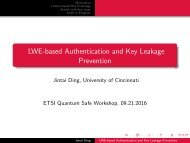RedirectToSMB_public_whitepaper
RedirectToSMB_public_whitepaper
RedirectToSMB_public_whitepaper
Create successful ePaper yourself
Turn your PDF publications into a flip-book with our unique Google optimized e-Paper software.
REDIRECT TO SMB<br />
In addition to these methods, one should use a strong password. Many methods of leveraging<br />
the results of Redirect to SMB rely on cracking the password. Password policies should be<br />
updated over time to reflect the cost of hardware used to crack passwords. With the rise of<br />
high-powered, GPU-based hash cracking, the time required to compute NTLMv2 hashes has<br />
dropped significantly.<br />
5.0 - SMB Authentication Encryption<br />
SMB authentication’s encryption has changed a bit over the years, but by default allows for<br />
servers to request backwards compatibility. If the default configuration is modified, the SMB<br />
client on Windows will decline some forms of the backwards compatibility. Given that fact,<br />
we’ll focus on the password encryption algorithm used when the backwards compatibility is<br />
completely disabled.<br />
NTLMv2 (a one way encryption/cryptographic hash) was introduced to SMB in 1998 (http://<br />
web.archive.org/web/19990117055557/http://www.microsoft.com/ntserver/nts/exec/overview/<br />
NT4SP4whatnew.asp). The hash cracking community will often refer to this algorithm as<br />
NetNTLMv2 to avoid confusion with the simple NTLM hash. Without going into too much detail<br />
about the hashing algorithm, the important details are as follows:<br />
• The server sends the client an 8 byte salt<br />
• The client creates an NT hash (the password is encoded with UTF-16LE then encrypted<br />
with the MD4 algorithm) (http://en.wikipedia.org/wiki/MD4)<br />
• The client then creates an MD5 HMAC, using the NT hash as the key, and the User +<br />
Domain as the message<br />
• Then the client generates a salt of its own (8 byte random, then additional bytes<br />
representing the time and additional information)<br />
• The client then creates an MD5 HMAC, using the previous MD5 HMAC as the key, and<br />
the server’s salt + the client’s salt as the message.<br />
• The client then sends the resulting MD5 HMAC hash to the server along with the<br />
client’s salt.<br />
In 1998, this was a reasonable method, as it ruled out the use of Rainbow Tables in order<br />
to crack these hashes. Rainbow Tables rely on pre-generating hashes for all the passwords<br />
matching certain rules, which was a major discovery before the advent of the GPU hash<br />
cracker. By using two salts, NetNTLMv2 avoided Rainbow Tables being generated with a static<br />
server salt.<br />
When properly salted and assuming no algorithmic weakness, the strength of cryptographic<br />
hashes is based on how long it takes for an attacker to guess a single password. As the<br />
software and hardware used to attack these hashes evolves, the cryptographic hashes being<br />
used should also evolve. Considering that NTLMv2 was implemented in 1998, one might<br />
wonder how it has managed to keep up with the explosion of low cost, high power GPUs being<br />
15



